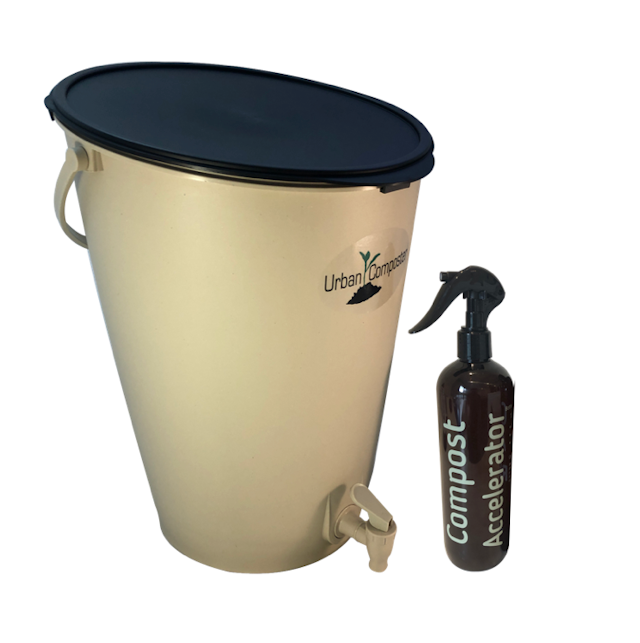Cass Marketos | April 24, 2020
Why is this interesting - The Composting Edition
On climate change, landfill emissions, and a homespun solve
Recommended Products

A modestly-priced composting bin for kitchen use.
Cass Marketos (CM) is a friend of WITI/writer and digital strategist based in Los Angeles. She’s built communities at Kickstarter, Google, and the Obama White House. Call her for your most interesting content strategy and community engagement projects. - Colin (CJN)
Cassie here. Last week, I was browsing through saved tabs when I came across an article in the New Yorker regarding the success of a national composting initiative in South Korea. The piece is objectively fascinating for both the simplicity and scalability of the effort (fees for trash disposal, widely available and automated recycling bins, basement mushroom farms), but what jumped out at me most was a simple, contextual fact about food waste: organic matter, deprived of oxygen as it decomposes in landfills, emits methane—a climate poison cited as 56x more deadly than carbon.
Why is this interesting?
When it comes to the health of our natural world, more seems out of hands than under our control, and the options we have as individuals seem despairingly limited. Too many of the “solutions” presented by the market simply overlay existing consumption habits—clothing brands market their (allegedly) sustainable supply chains, airlines offer the option to purchase carbon offsets—versus requiring us to make real, meaningful change, and it can be hard to parse where and how our independent efforts might add up to something actually impactful.
Enter the landfill.
The United States has the highest landfill emissions of any country. Put another way: “the equivalent of thirty-seven million cars on the road each year.” That’s a staggering amount, but also a potentially significant leverage point:
...recycling of organics—food waste, yard waste, pretty much anything that rots—remains voluntary, even though such material makes up about a third of New York’s trash. All but five per cent of the city’s organic waste goes to landfills.
According to GrowNYC, organic material (i.e. “food”) comprises a full 21% of NYC’s waste stream. The city then pays for much of this material to be shipped out-of-state to be disposed of in landfills, where it rots and generates methane. This is comically counterproductive, particularly because most neighborhoods in New York City offer curbside pick up for composted material, an offering that remains woefully underutilized:
About a third of New Yorkers can sign up to have their organic waste collected from their homes, in brown bins, but many people are unaware of the program. Even in participating districts, only about ten per cent of organic matter is diverted from landfills. I asked a middle-aged man listening to music if he knew what a brown bin nearby was for. “Bones?”’
I’m doubtful that these programs see lax participation because people are disinterested. My guess is that they simply don’t know. (Casual conversation with otherwise very well-informed friends has revealed a stunning dearth of knowledge around how waste management relates to climate justice, generally.) Statistics from other cities with mandatory organic waste recycling programs reveal promising results. San Francisco, for instance, “San Francisco launched mandatory organics recycling in 2009, and now diverts eighty percent of food waste; a comparable model in Seattle has led to about sixty percent of total waste being recycled.”
Ideally, composting emerges as a new American habit through a system of subsidies and state-supported infrastructure, which enables individual households to easily and affordably take part. Transitioning to these types of programs is not always cheap (updating truck infrastructure, building, and maintaining disposal and redistribution sites), but the long term could be extremely beneficial for public health and, yes, even the economy.
In the meantime, there are plenty of options for the at-home composter who would choose to take initiative. First, you can find out if curbside pickup is typically available in your neighborhood. (Worth noting: many programs, unfortunately, have been temporarily suspended in respect to COVID.) Second, you can purchase a modestly-priced composting bin for your own kitchen. This urban composter kit is $40. If you’re feeling thrifty, food scraps can be collected in discarded yogurt containers or old milk cartons. Even a plastic bag will suffice. To avoid odors, you can also store these items in your freezer.
A bittersweet side effect of the COVID-related shutdown has been a significant reduction in emissions, which has permitted people in typically pollution-choked areas to suddenly, well, see. Mountaintops are visible for the first time in decades, as are city skylines and basic parkways. If there was ever a time to motivate regarding an ongoing commitment to reducing toxic emissions, now is it. And while I don’t pretend that households deciding to compost is a silver bullet for saving the planet, it certainly represents an essential step. (CM)
Photo of the Day:
According to the Library of Congress, “Poster shows boy with hoe chasing fleeing vegetables to illustrate the success of growing food in local "victory gardens." Part of the National War Garden Commission's campaign to encourage Americans to raise more food and free resources for the United States military needs in World War I.” Artist: Maginel Wright Barney (1877-1966) (CM)

Quick Links:
More info on composting at home and disposal in New York City (CM)
Food artist sending Sourdough Around the World (CM)
WWII Victory Gardens make a comeback (CM)
Thanks for reading,
Noah (NRB) & Colin (CJN) & Cass (CM)
—
Why is this interesting? is a daily email from Noah Brier & Colin Nagy (and friends!) about interesting things. If you’ve enjoyed this edition, please consider forwarding it to a friend. If you’re reading it for the first time, consider subscribing (it’s free!).